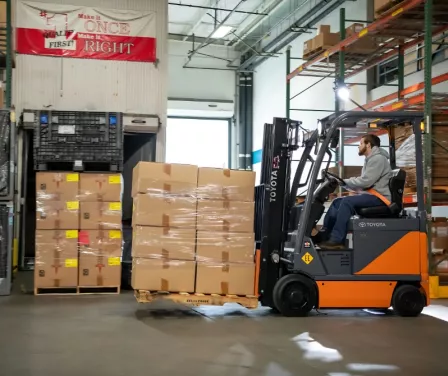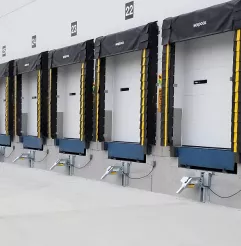Rent
ProLift offers daily, weekly, and monthly rentals. Find the right equipment for maximum productivity and safety.
Let us know how we can assist you! A ProLift specialist will connect with you to help with your material handling needs.

Loading and unloading trailers at the dock can present serious safety hazards if not handled properly. Gain awareness of common risks associated with dock work and provide tips for preventing accidents.

Loading and unloading a trailer requires the forklift operator to interact with both another piece of equipment (the trailer) and another person (the truck driver), increasing the potential for safety risks and hazards.
It is also important the forklift operator be aware of the truck driver. The fast pace and pressure to deliver loads can result in drivers prematurely pulling away from docks with a forklift inside. Other times, an operator may drive off the dock if they expect the trailer to be in place.
In addition to setting the brakes on the truck, forklift operators must not drive fast or get aggressive with the forklift brakes inside a trailer. If an operator quickly enters a truck and slams on the brakes, the weight of the forklift and its load will move a trailer even if the truck brakes are set and the wheel chocks are in place. Dock locking systems cannot be trusted blindly since rear impact guards (ICC bars) on trailers can be damaged or missing.
Moveable rear trailer axles must be in the most rearward position. If the operator loads or unloads a dropped trailer, they must use a jack stand to support the front of the trailer.
Elevated dock areas pose potential for forklift tip-over, the leading cause of operator fatality. Forklift operators must look backwards to guide them out of the trailer and not rely on peripheral vision. If the operator waits to look back only after hearing the forklift's steer tires hit the dock plate, they may not realize the truck has already pulled away, causing the forklift to fall off the trailer. Additionally, a pedestrian walking behind the trailer could be at risk of being struck.
Companies can take control of dock safety by having the proper safety equipment and strategies.
ProLift can help you with dock equipment and maintenance programs. Contact a warehouse solutions sales consultant to schedule an on-site evaluation.

It’s hard to know what’s accumulated under and around your dock equipment. Dock and door failures put your employees at risk and can cause further damage to your dock equipment.
As a full-service material handling dealer, ProLift can help you with questions and solutions for your equipment, service, parts and more. Tell us how we can help.

Let us know how we can assist you! A ProLift specialist will connect with you to help with your material handling needs.
